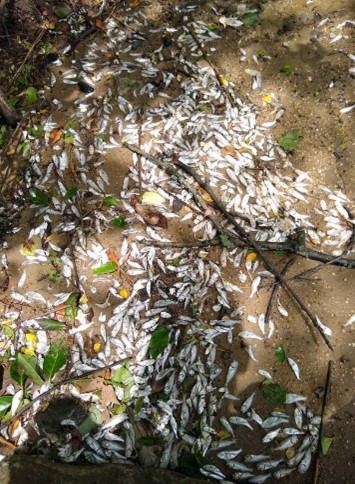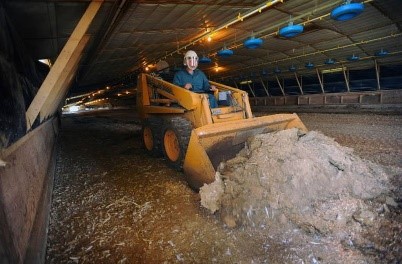Agriculture is destroying the Chesapeake Bay

Spa Creek fish kill emblematic of the failure to curb nutrients with agriculture the #1 source. (Courtesy Photo)
After 39 years of the Chesapeake Bay Program, efforts to restore the bay are foundering.
The U.S. Environmental Protection Agency acknowledged that the most critical requirements for restoring the bay — reducing excess nutrients — would not be met by 2025 as mandated by the EPA in 2010 after 27 years of bay states failing to meet voluntary agreements to do so.
Deadlines for reducing nitrogen and phosphorus also had been set for 2000 and again for 2010 and went unmet without EPA sanctions.
In 2010, the EPA was forced by a court settlement under the Clean Water Act to set mandatory pollution reductions for the first time. The states were generously given 15 years to do so or face sanctions.
But in October, bay “leaders” painted over the glaring failure and instead held a self-congratulatory media session of Green Washing touting their great successes. The EPA administrator, governors and lawmakers celebrated all they had done for the bay and skirted the real issue of missing the nitrogen limits by a whopping 40 million pounds. They failed to announce any measures of how they would do so in the future.
Instead, the EPA again failed to impose sanctions and discarded the 2025 deadline to “recalibrate” restoration goals making a mockery of the Chesapeake Bay Program and its mandates.
This occurs as 70% of the bay’s waters are so polluted they violate basic Clean Water Act requirements. For three consecutive years water quality declined. Just 29.6% of bay water fully met CWA requirements in 2020.
In 1985, 26.5% of waters met these legal requirements — miniscule progress after 38 years and billions of dollars spent. The Chesapeake Bay Foundation’s 2023 report card rated the bay a condemnatory D+.
The results of this abysmal restoration failure: flesh-eating diseases threatening human life from bay water contact as bacteria proliferate; collapsed or collapsing fisheries — oysters, soft clams, shad, rockfish, sturgeon and crabs; and losses of critical underwater grasses.
So how did this happen?
Great progress in reducing nitrogen and phosphorus from wastewater (sewage) plants is a singular success. Remarkably, since 1985 bay wastewater nitrogen was reduced by 60 million pounds a year, a 63% reduction despite huge increases in wastewater flows from a population increase from 13 million to 18.5 million.
This occurred under EPA mandates as the public paid billions of dollars for advanced nutrient removal. In Maryland, the so called Flush Tax has raised $1.5 billion for such nutrient reductions.
But agricultural pollutant reductions have lagged far behind. The bay region’s 83,000 farms cover 25% of the land and are the largest source of bay pollutants: 50% of nitrogen; 45% of phosphorus; and 60% of bay choking sediment.
Nitrogen flows have changed little since the new cleanup mandates were ordered in 2010. This is despite more than $5 billion in federal and state subsidies paid to farmers to voluntary reduce pollutants since 1985, $2 billion since 2010. About 123 million pounds of nitrogen reached the Chesapeake from farms in 2009; by 2021, just 6 million pounds were reduced, less than 5%.
To meet the EPA 2025 requirements, total nitrogen flows must be reduced by 40 million pounds, primarily from agriculture. Tragically, according to bay guru Karl Blankenship, it appears this reduction will not be achieved for many decades, perhaps not until 2100.
This would doom the restoration of the Chesapeake Bay. Farmers are ramping up production on farmland, growing more nitrogen intensive corn and soybeans and increasing livestock production, especially chickens.
The political will to take the actions to achieve necessary farm nitrogen reductions is non-existent as policy makers continue to believe throwing more money at farmers will do the trick.
Yields of nitrogen intensive corn, the most widely grown crop and the major source of ethanol, have grown about 400% per acre since the 1930s. Since 2009, farm animal numbers in the watershed—chickens, turkeys, cows, and hogs — increased by about 13% measured in pounds. There are 600 pounds of farm animals for every person in the watershed.
Between 1950 and 1982, the amount of nitrogen from manure and fertilizer applied to bay crop land nearly doubled, reaching 960 million pounds annually, as farmland decreased by nearly half. Alarmingly, the average annual rate of nutrient reductions from bay region farmland has actually decreased since 2009.
We are blessed in this country with an abundant, healthy and relatively cheap food supply which few civilizations in history have attained.
The Green Revolution ushered in these huge increases in yield per acre as massive amounts of fertilizers, especially nitrogen, were applied as well as increases in pesticides. We produce so much food and fiber that over-consumption presents problems including obesity and Type-2 diabetes.
In 2022, we exported a record $196 billion in food products, with China the major recipient. Corn and soybeans led the way, both nitrogen intensive and leaky crops.
China imported more than half of the 48% of soybeans exported. About 15% of corn was exported while 45% was used for ethanol under a federal boondoggle mandating 15% ethanol in motor vehicle fuel. This causes a 24% increase in global warming emissions and raises the price of food for millions of people.
Net farm income hit a record $160 billion in 2022 while federal subsidies continued. In 2020, these subsidies accounted for 50% of net farm income. In May, the Washington Post editorialized: “Want fiscal responsibility? Stop paying wealthy farmers” detailing how $80 billion could be saved by doing so over the next decade.
America’s acumen in intensifying agriculture has come with enormous environmental costs. Declining surface water quality is but one of those costs. Groundwater contamination from excess nitrogen threatens humans using well water on the Eastern Shore.
Fine-particulate air pollution emissions from farms outweigh all other human sources in much of the U.S., Europe, Russia and China leading to disease and death. Farm pesticides also wreak havoc with human health wildlife, and insect pollinators.

A record 596 million chickens were grown on the Eastern Shore producing 1.4 billion pounds of chicken poop, equivalent to the weight of 93,000 huge African bull elephants. Most was dumped on land polluting the Bay. (Baltimore Sun Media File Photo)
These bay farm pollutants are by far the most cost-effective per pound to reduce. At the heart of our failure to do so are warm and fuzzy public attitudes toward agriculture.
Citizens want to clamp down on developers, industrial dischargers and sewage treatment plants. They resort to lawsuits over their pollutants. These same citizens and their elected officials place farmers and agriculture on pedestals as “White Hats” while developers are castigated as “Black Hats.”
The environmental community, led by the Chesapeake Bay Foundation, has gone soft on agriculture. CBF has taken more than $21 million from USDA and other agribusiness interests to work with farmers. It is missing in action in seeking more stringent regulation and enforcement.
Instead, CBF only proposes paying farmers more and more to lessen pollutant loads. Tom Pelton, a former senior researcher and writer at CBF, wrote in his book that CBF has gone from Save the Bay to Trade the Bay.
Sadly, without a paradigm change, the Chesapeake Bay will never be any healthier than it is now. It might descend into a more polluted body of water especially with an increasing population and more intensive agricultural operations. Next week’s column will have details on how to get us back on track.
Gerald Winegrad represented the greater Annapolis area as a Democrat in the Maryland House of Delegates and Senate for 16 years. Contact him at gwwabc@comcast.net.